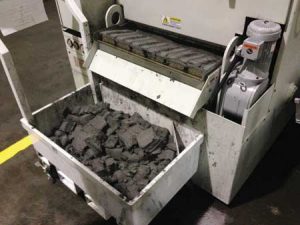Rare Earth Magnetic Filtration for the Metalworking Industry (Originally published in Manufacturing News Magazine)
 Flow Pro Products’ high-strength rare earth magnetic filters are designed to deliver high-performance filtration levels for minimally ferrous materials such as high-speed steels, tool steels and carbides, and final metalworking processes for close tolerance component manufacturing. According to the company, these filters are capable of maintaining machine tool coolants to 10 um nominal clarity, without the need for consumable filtration media.
Flow Pro Products’ high-strength rare earth magnetic filters are designed to deliver high-performance filtration levels for minimally ferrous materials such as high-speed steels, tool steels and carbides, and final metalworking processes for close tolerance component manufacturing. According to the company, these filters are capable of maintaining machine tool coolants to 10 um nominal clarity, without the need for consumable filtration media.
“Processes like super-finishing, honing, micro-sizing, lapping and burnishing generate very small particulate and make filtration operations challenging, expensive and maintenance intensive,” said a company spokesperson. “The system is capable of removing solid particulate down to a nominal clarity of 10 um, yielding an average particle loading of 50 PPM or less. These Rare Earth Magnetic Filtration Systems eliminate the operational expenses of purchased filter media and filter-aid powders. They also eliminate the maintenance intensive chores involved in operating complicated filtration processes.
 “The Rare Earth Magnetic Filters use an extended pole design, high-power Neodymium Iron Boron drum construction and the logic employed to index the drum, automatically on demand. Compared to smooth cylindrical drums that rotate continuously, the raised pole design employs 40% more magnetic surface area per linear foot. The drum is designed to index on demand and does not rotate continuously, so the captured contaminants that are discharged are drier, and that in turn reduces coolant loss. Our automatic indexing control logic will only rotate the drum when the fluidic probe generates a signal, which occurs as the captured contaminants continue to build up in the intense magnetic field. The purpose behind this circuitry is to maintain the optimum porosity of the filter matrix which is dictated by the application, flow rate and the sizing selection. This results in reliable and efficient filtration and removal of magnetic and non-magnetic contaminants from metalworking coolants.”
“The Rare Earth Magnetic Filters use an extended pole design, high-power Neodymium Iron Boron drum construction and the logic employed to index the drum, automatically on demand. Compared to smooth cylindrical drums that rotate continuously, the raised pole design employs 40% more magnetic surface area per linear foot. The drum is designed to index on demand and does not rotate continuously, so the captured contaminants that are discharged are drier, and that in turn reduces coolant loss. Our automatic indexing control logic will only rotate the drum when the fluidic probe generates a signal, which occurs as the captured contaminants continue to build up in the intense magnetic field. The purpose behind this circuitry is to maintain the optimum porosity of the filter matrix which is dictated by the application, flow rate and the sizing selection. This results in reliable and efficient filtration and removal of magnetic and non-magnetic contaminants from metalworking coolants.”
Applications include the following, according to the company:
- Grinding
- Centerless I.D. and O.D.
- Thrufeed
- Cylindrical roll
- Double disc
- Creep feed and thread grinding
- Tool steel grinding
- Carbide grinding
- Honing
- Micro sizing
- Wire drawing
- Tube rolling.
Originally Published on Manufacturing News Magazine.
